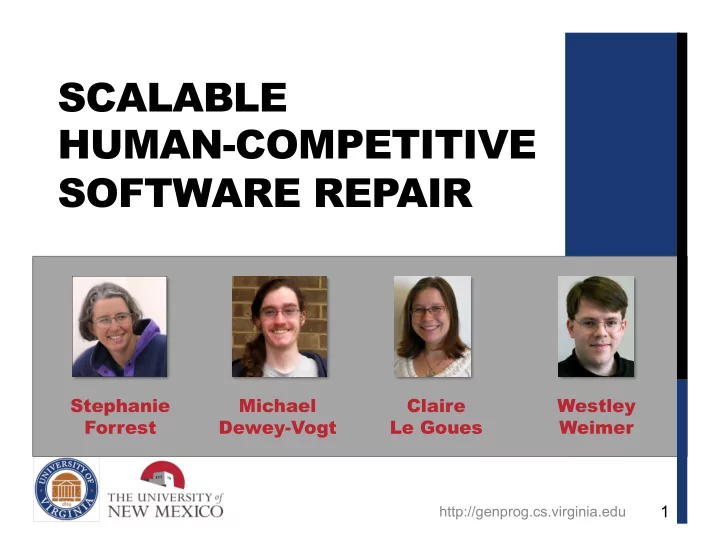

SCALABLE HUMAN-COMPETITIVE SOFTWARE REPAIR Stephanie Michael Claire Westley Forrest Dewey-Vogt Le Goues Weimer 1 http://genprog.cs.virginia.edu
“Everyday, almost 300 Annual cost of bugs appear [ … ] far too many for only the Mozilla software errors in the programmers to handle.” US: $59.5 billion – Mozilla Developer, (0.6% of GDP). 2005 PROBLEM: BUGGY SOFTWARE 10%: Everything Else Average time to fix a security-critical error: 28 days. 90%: Maintenance 2 http://genprog.cs.virginia.edu GECCO Humie 2012
BUG BOUNTIES: $20-$3000+ PER PATCH 3 http://genprog.cs.virginia.edu GECCO Humie 2012
E.G., GOOGLE PAID $11,500 IN BOUNTIES BETWEEN MAY 23, 2012 AND JUN 26, 2012 Tarsnap: 125 spelling/style 63 harmless 11 minor + 1 major 75/200 = 38% TP rate $17 + 40 hours per TP 4 http://genprog.cs.virginia.edu GECCO Humie 2012
GENPROG: EVOLVING SOFTWARE REPAIRS 5 http://genprog.cs.virginia.edu GECCO Humie 2012
WHY WE ARE HUMAN COMPETITIVE Effective: Tested on 105 human-repaired bugs in over 5 million LOC GenProg automatically repaired 60 (57%) Tarsnap CEO found 38% rate “worth every penny” Security repairs tested using Microsoft’s fuzz-testing std Cheap: $7.32 per TP (successful bug fix) Tarsnap paid $17 per TP, IBM pays $25 Fast: 96 minutes (wall clock) Compared to 40 hours for Tarsnap Quality (ISSTA to appear): GenProg-patched code + machine-generated documentation is more maintainable than Human-generated patches + commit message 6 http://genprog.cs.virginia.edu GECCO Humie 2012
SYSTEMATIC EVALUATION Question: “If I were to use your technique on the next 100 bugs that were filed against my project, how many would it fix, how much would that cost, and how long would it take?” Goal: a large set of important, reproducible bugs in non-trivial programs. Approach: use historical data of important, reproducible bugs in non-trivial programs Consider popular programs from SourceForge, Google Code, l Fedora SRPM, etc Bugs merited a developer-written test case and a bug report l “severity” of 3/5 or more Use all pairs of viable versions from source control repositories. l “Lock in” our algorithm first, then gather up all bugs. l Evaluate in Amazon EC2 cloud l 7 http://genprog.cs.virginia.edu GECCO Humie 2012
BENCHMARKS Bugs Program Description LOC Tests Fixed Total fbc Language (legacy) 97K 773 1 3 gmp Multiple precision math 145K 146 1 2 gzip Data compression 491K 12 1 5 libtiff Image manipulation 77K 78 17 24 lighttpd Web server 62K 295 5 9 php Language (web) 1,046K 8,471 31 44 python Language (general) 407K 355 1 11 wireshark Network packet analyzer 2,814K 63 3 7 Total 5,14M 10,193 60 105 8 http://genprog.cs.virginia.edu GECCO Humie 2012
SCALABILITY In 2009, we demonstrated that it was possible to repair bugs using GP Evaluated on small/toy programs with small test suites, no l direct cost comparisons, no systematic quality comparisons 2012: human-competitive scalable repairs for off-the-shelf, real- world bugs ~100x more code, ~200x more tests, ~10x more bugs (and l bugs that matter!), systematic study, direct time measurements (e.g., 96 minutes vs. 40 hours), direct cost measurements (e.g., $8 vs. $17), direct maintainability measurements 9 http://genprog.cs.virginia.edu GECCO Humie 2012
CONCLUSION GenProg addresses a critical and challenging problem (0.6% US GDP) Better than humans on quantitative metrics used in software industry. Systematic selection of benchmark programs and bugs Scalability achieved through algorithmic innovations 10 http://genprog.cs.virginia.edu GECCO Humie 2012
Recommend
More recommend